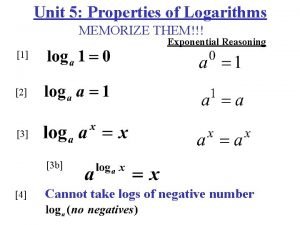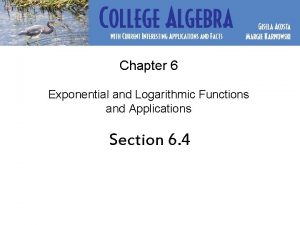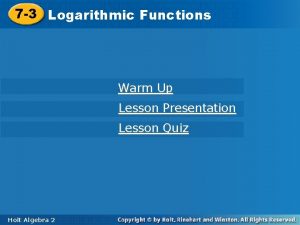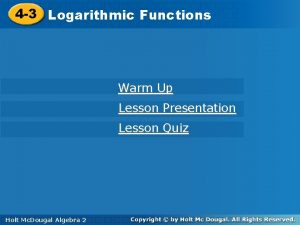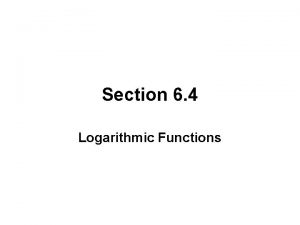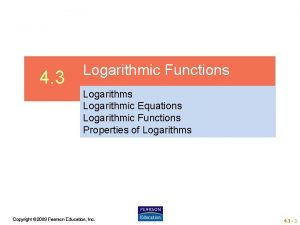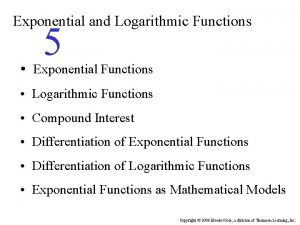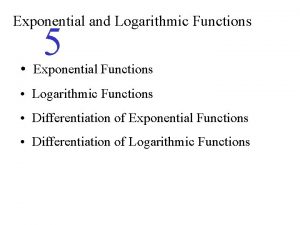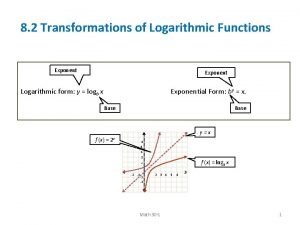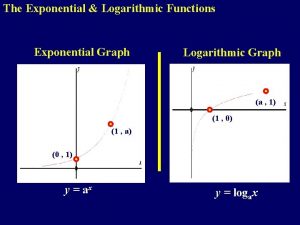Logarithmic Functions 3 2 The logarithmic function to

















- Slides: 17

Logarithmic Functions 3. 2

The logarithmic function to the base b, where b > 0, b 1 and x > 0, is defined: y = log b x if and only if x = b y logarithmic form Convert to exponential form: exponential form Convert to log form: When converting from exponential to logarithmic form, the exponent of the exponential becomes the value of the logarithm.

Practice: 1. Write each equation in its equivalent exponential form: 2. Write each equation in its equivalent logarithmic form:

LOGS = EXPONENTS With this in mind, solve: 2 to what power gives 16? 3 to what power gives 1/9? 4 to what power gives 1? When working with logs, re-write any radicals as rational exponents. 3 to what power gives 3 to the 1/2?

Practice: Evaluate each expression without using a calculator:

Basic Logarithmic Properties

Remember our natural base “e”? We can use that base for a logarithm. e to what power gives 2. 71828? ln Since the log with this base occurs in nature frequently, it is called the natural log and is abbreviated ln. Locate the ln button on your calculator - it is the same key that has ex above it. The calculator lists functions and inverses using the same key but one of them needing the 2 nd (or inv) button.

Another commonly used base is base 10. A log to this base is called a common log. Since it is common, if we don't write in the base on a log it is understood to be base 10. 10 to what power gives 100? 10 to what power gives 1/1000? This common log is used for things like the Richter scale for earthquakes and decibels for sound. Locate the log button on your calculator - it is the same key that has 10 x above it. Again, the calculator lists functions and inverses using the same key but one of them needing the 2 nd (or inv) button.

Practice: Evaluate each expression without using a calculator:

Basic Properties of Logarithms

Logs and exponentials are inverse functions of each other, and for functions and their inverses, x’s and y’s trade places. Therefore, anything that was true about x’s or the domain of a function, will be true about y’s or the range of the inverse function and vice versa. Let’s compare the characteristics of the graphs of exponential and logarithmic functions.

Characteristics of the Graph of an Exponential Function , b>1 q Domain is (- , ) Characteristics of the Graph of a Logarithmic Function , b>1 q Range is (- , ) q Range is (0, ) q Domain is (0, q There are no x-intercepts q There are no y-intercepts ) because there is no x value to make y = 0 q The y-intercept is always (0, 1) because b 0=1 q The x-intercept is always (1, 0) (x’s and y’s trade places) q The graph is always increasing q The x-axis (where y = 0) is a horizontal asymptote for x - q The y-axis (where x = 0) is a vertical asymptote

Exponential Function Graphs of inverse functions are reflected about the line y = x Logarithmic Function

Transformation of functions apply to logarithmic functions just like they apply to all other functions: up 2 left 1 Reflect about x axis

When graphing, we need to find x-intercept of a function. Find x-intercept of - solve the equation: Convert this to exponential form Check: This is true since 23 = 8

Finding the Domain of a Logarithmic Function Find the domain of the function: Expression under the logarithm must be positive, therefore: Can you name the vertical asymptote? The domain of is

Practice: Find the domain of each logarithmic function:
 Unit 8 review logarithms
Unit 8 review logarithms Properties of e
Properties of e Unit 5: exponential and logarithmic functions answers
Unit 5: exponential and logarithmic functions answers Examples of exponential equations
Examples of exponential equations What kind of pattern
What kind of pattern Chapter 6 exponential and logarithmic functions answers
Chapter 6 exponential and logarithmic functions answers Logarithmic rules
Logarithmic rules Chapter 4 exponential and logarithmic functions
Chapter 4 exponential and logarithmic functions Site:slidetodoc.com
Site:slidetodoc.com Lesson 10-2 exponential growth and decay
Lesson 10-2 exponential growth and decay Chapter 5 exponential and logarithmic functions answers
Chapter 5 exponential and logarithmic functions answers 7-3 lesson quiz
7-3 lesson quiz Integral of logarithmic functions
Integral of logarithmic functions 4-3 logarithmic functions answers
4-3 logarithmic functions answers Transforming exponential and logarithmic functions
Transforming exponential and logarithmic functions Reverse exponential graph
Reverse exponential graph Chapter 5 exponential and logarithmic functions
Chapter 5 exponential and logarithmic functions Expanding logarithims
Expanding logarithims

